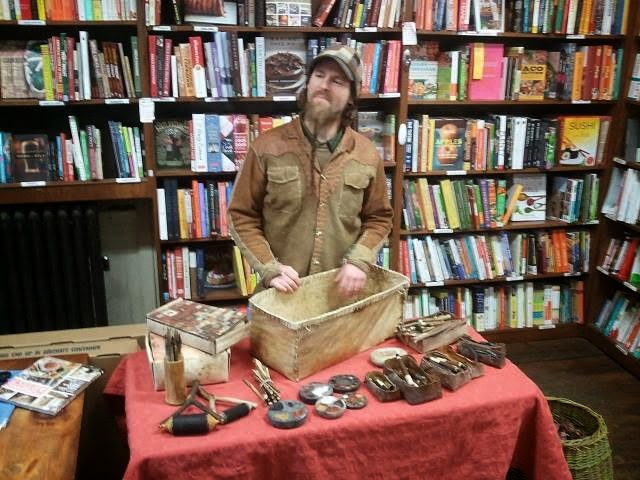I admit that when I first picked up a copy of Nick Neddo's The Organic Artist and it fell open to the page where he lays goat hairs into paintbrush formation with a pair of tweezers I thought "You have got to be kidding me" (the revelation that a painting not included in the book is a portrait of a cat rendered by a cat whisker brush didn't help the cause).
To be fair, I started on a particularly unlucky page where even the uber-patient author warns "this is tedious." The book had plenty of other options, grinding rocks for mineral-based paints, making drawing charcoal (that I can do!). . . even the papermaking, while delicate, involves enough maceration action for the fibers to keep me entertained. The books gives instructions for dozens of projects to turn natural materials into art supplies.
Here is where I, and other fans, caught onto the spirit of The Organic Artist: we remember being kids, playing outside, with hours to fill and a fascination with making pictures from what we found around us. It's an intersection of the natural world and our early ability to craft something from that world.
I'd forgotten about playing with gathered material to make images until Nick reminded me. I didn't think of it as budding artistry so much as being really bored. Now that it's clicked, I can remember all sorts of games: making paper from grass clippings, taking sharp rocks from the driveway to flat rocks on our stonewall to scratch out lines, taking charcoal from campfires to draw on the trunks of birches, a fascination with plants that could dye my hands different colors (we had a black walnut tree - that was good for a lot of staining), acorn caps laid out in patterns, even just making black raspberry "stamps" on the back of my hands. Starting from a similar instinct, Nick went on to create detailed art from carefully designed tools. From black raspberry stains he's advanced all the way to having his own exhibit at the Vermont Arts Council.
 |
| An image from the book, showing different inks made from common plants |
Nick came to Bear Pond Books on February 6th as part of the Montpelier Art Walk. Fans of every age came to look at his array of homemade pens, brushes, crayons, ink rollers, ink pots, and inks to go in them. They also got to see Nick working on a picture of staghorn sumac drawn with sumac ink and a pen made with a sumac twig. The infamous cat drawing was there. And you can see other examples of Nick's work at his website www.nickneddo.com
Nick says that he sees how older children quickly lose the creative instinct to make art from the natural materials surrounding them. Perhaps because they get frustrated when their pictures don't look the way they imagine, or maybe because they start to sift out into "artsy" kids and "outdoors" kids - one group hunts deer, the other draws them. One goal of the book, and classes he teaches, is to get kids who are interested in art also interested in nature, and kids interested in exploring nature interested in art . . . and for the ones already interested in both, so much the better.
The Organic Artist taps into an impulse to blend nature and art that a lot of us have forgotten was there to begin with. It's an intriguing source of inspiration for art classes, history classes, and environmental studies. Nick may also be expanding his workshop offerings for folks who want instruction beyond the book. Learn more at www.nickneddo.com.
(Review by Helen)




No comments:
Post a Comment